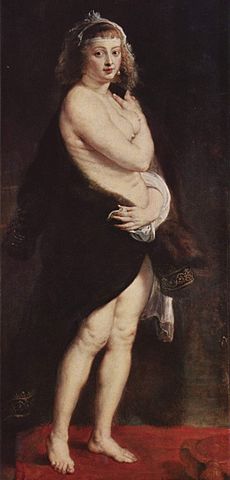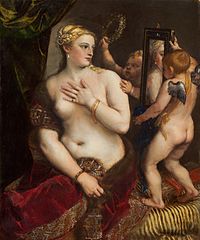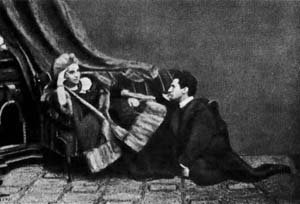Leopold von Sacher-Masoch, Poet of Masochism
 In the 19th century, when modern clinical psychology was being born, it may have seemed reasonable for the notoriously depraved Marquis de Sade to have been associated with “sadism”. Few raised an eyebrow when the long-dead French author’s name was appropriated to name those who took pleasure in another’s pain. But when Leopold von Sacher-Masoch had his name taken for the mirrored vice of masochism, finding pleasure in one’s own pain, then there were more protests. For Leopold was still alive, albeit in diminished health, in 1886 when Richard von Krafft-Ebing decided to use his name in his book Sexual Psychopathy: A Clinical-Forensic Study. Facing criticism and accusations of slander, Von Krafft-Ebing wrote:
In the 19th century, when modern clinical psychology was being born, it may have seemed reasonable for the notoriously depraved Marquis de Sade to have been associated with “sadism”. Few raised an eyebrow when the long-dead French author’s name was appropriated to name those who took pleasure in another’s pain. But when Leopold von Sacher-Masoch had his name taken for the mirrored vice of masochism, finding pleasure in one’s own pain, then there were more protests. For Leopold was still alive, albeit in diminished health, in 1886 when Richard von Krafft-Ebing decided to use his name in his book Sexual Psychopathy: A Clinical-Forensic Study. Facing criticism and accusations of slander, Von Krafft-Ebing wrote:
During recent years facts have been advanced which prove that Sacher-Masoch was not only the poet of Masochism, but that he himself was afflicted with the anomaly. Although these proofs were communicated to me without restriction, I refrain from giving them to the public.
In fact it was not until 1906, eleven years after Leopold’s death, when a book entitled Meine Lebensbeichte (“My Confession”) was published that the proofs von Krafft-Ebing referred to came out. As a result, one of the most admired writers of the 19th century had his posthumous reputation so damaged that he became almost a mere footnote in a psychology textbook. But was that justified?
Leopold was born in 1836 in the city of Lemberg, the capital of the Kingdom of Galicia and Lodomeria. At the time the kingdom was part of the Austro-Hungarian Empire, one of the possessions of the Hungarian half of that strange composite country. Nowadays it is part of Ukraine, and the city is called Lviv. Leopold’s father was an Austrian noble of the von Sacher family, while his mother was the last of the Western Ukrainian noble von Masoch family. Rather than have her name die out, she persuaded her husband to combine it with his own to create the von Sacher-Masoch name. Young Leopold was less influenced by his parents, however, than by his nurse, a Ukrainian peasant woman named Handzya. In later life he would write that he “owed her his soul”, for the inspiration from her tales of Ukrainian folk legends and ancient songs; as well as historical tales of the cruelty of Ivan the Terrible, and of Esterka, the Jewish mistress of the great Polish king Casimir. Though a pragmatic approach to European affairs at the time meant that he was generally most well served by being an Austrian, it seems that in his heart Leopold always considered himself of his mother’s people.

When Leopold was twelve, the family were forced to flee Lemberg after a peasant revolt broke out. The sight of his childhood home torn apart, and the extreme brutality with which the Austro-Hungarians put down the rebellion, had a profound effect on the young Leopold. It was rumoured later that his father had deliberately incited the rebellion as a pretext for the Empire to stamp its authority on the territory. The family moved to Prague (part of the Austro-Hungarian Empire at the time) where the rebellions tearing across Europe in the tumultuous summer of 1848 also made their mark. Leopold later told the story of how he found himself out in the streets when the revolution broke out:
Miroslawa (Leopold’s cousin) came running in the garden, where I was at that time. She was wearing a blue jacket, trimmed with white fur and a red cap. Two pistols and a dagger adorned her belt…On the barricade she was a beautiful Amazon, rifle in hand.
Though admonished and ordered to go home, still the scene had a definite effect on the young man’s view of the world, and of women in general. He refers to the Amazon on the barricades several times in his later work. Equally influential was a trip to Vienna, where the teenage Leopold discovered in the Imperial Museum a portrait of Helena Fourment, by her husband the great Dutch painter Peter Paul Rubens. In an image that would haunt both his work and his personal life work the painting shows her naked, wrapped in furs.

By the age of 20, Leopold had gained a doctorate and was teaching history at the University of Graz. Inspired by the history he was teaching to capture the history he had seen in his youth, he wrote a historical account of the uprising in Prague, followed by a second book about the Galician uprising. He moved back to Lemberg and taught there through his twenties, publishing several more historical books. Eventually he decided to forgo the teaching, and become a full time writer, and in the 1860s he began to wander Europe. In 1862 in Vienna he met Anna von Kottowitz, with whom he had an affair that lasted for four years. It ended when he discovered that she had been also having an affair with his servant. The affair inspired his first popular non-historical novel, The Divorced Woman, which was even translated and published in America. In it he portrays his affair with Anna as that of a married protagonist, though he made it clear that it was based on personal experiences. The process of writing it seems to have helped to crystallise the framework that would form the shape of the rest of his work, as that year he began work on his great masterpiece, The Legacy of Cain.
The premise of Leopold’s planned six-volume epic was that the biblical figure Cain had through his crimes unleashed six evils upon the world, each of which would be the central theme of a collection of loosely linked stories. The six evils, as explained by a wandering monk to a hunter in the introduction to the series, are Love, Property, Countries (or “The State”), War, Work and Death. Leopold’s writing for the next fifteen years would slot into this framework. In the end only Love and Property were actually completed, each with six novellas. Death was half-completed with three novellas, while Countries and Work received one each, and no novel in the War theme was written before Leopold abandoned the project. Though he failed to complete the series, it’s hard to call it a failure, as it produced some of his best writing. Love, in particular (which was completed in 1870, before any work on the rest of the series was done) produced a novella which became Leopold’s most famous work – Venus In Furs.

The title of the novel comes from a dream the unnamed narrator has, which in the novel is tied to Titian’s Venus With a Mirror (but which clearly also ties to the Rubens painting Leopold saw as a boy). The narrator then reads a manuscript which tells of a man named Severin, who becomes so infatuated with a woman named Wanda von Dunajew that he asks her to make him her slave. Wanda finds the idea amusing enough that she agrees to it, though she remains contemptuous of Severin for allowing it. The pair travel around Europe, with Severin playing the part of Wanda’s servant and being ritually humiliated, until Wanda falls in love with another man and dissolves the arrangement so she can submit herself to his domination. Severin sums up the moral of the tale as this:
Woman, as nature has created her, and man at present is educating her, is man’s enemy…never his companion. This she can become only when she has the same rights as he and is his equal in education and work.
This proto-feminist sentiment is typical of the progressive slant of most of Leopold’s work, which was also notably advanced on matters of race and culture (Leopold being, for example, violently opposed to the anti-semitism which was endemic in Europe at the time). The novel won praise for the evocative descriptions, and the realistic emotional portrayal of Severin – hardly surprising however, as it would later turn out to be almost autobiographical.

The real Wanda was a woman with the improbable name of Baroness Fanny Pistor, with whom Leopold signed a contract which made him her slave for six months. There were only three provisos to the contract. The first, that he be allowed six hours a day for writing (which should be private). The second, that she “not demand anything of him that would dishonor him in any way (as a man or as a citizen).” And the third? That she “wear furs as often as possible, especially when she is behaving cruelly.” The two travelled through Italy, though Leopold’s desire to view ancient ruins was at odds with Fanny’s desire for urban excitement. In the end, however, it was Leopold’s attempt to bring in a third party – a Greek man in his fantasy, but in actuality an Italian actor named Salvini – that brought things to an end. Salvini became Fanny’s lover, but Leopold’s attempt (while masquerading as her servant “Gregor”) to interrupt the two and prompt Salvini into whipping him ended in such a ridiculous and humiliating fashion that he decided to abandon the entire experiment. Fantasy, it would appear, did not translate cleanly into reality.

Venus In Furs was very popular, and one person who read it was a young woman named Aurora Rümelin. Aurora was a poor girl from a broken home who was loaned the book by a friendly neighbour. At the time the neighbour told her that in her opinion Leopold needed a strong woman to bring him to heel. Aurora was fascinated by the idea of a man wanting to submit to a woman, and wrote to him, and the two soon began a correspondence. Aurora was guided by his novels to make herself into his “ideal woman”, and eventually the two met. When they began a relationship Leopold re-christened her Wanda von Dunajew, after his heroine, in order to concoct for her a noble past. The two soon signed a contract similar to that he had signed with Fanny, though she took it less seriously. Aurora, for her part, seems to have set out to secure him more on grounds of finance than passion – in her autobiography she confessed that she was driven by a desire not to be poor and hungry any more. When the two were married in 1873 (and she became legally “Wanda von Sacher-Masoch”) she even told him that she was a widow, to explain why she had previously lost her virginity. Not until after the birth of their first child did she admit the truth to him. It was perhaps the first sign that things would not go well between them.
Wanda later spoke of a personal life dominated by Leopold’s increasing fetishism. For her part, she began an affair with Armand Rosenthal, a journalist who Leopold knew. In 1883, while Leopold’s eldest son Alexander was dying of typhus, he discovered the affair. The two split acrimoniously, days before Alexander died. To add insult to injury, Leopold discovered that Armand had been systematically swindling him, and he was left virtually destitute. Perhaps unsurprisingly, this marked a sea change in his writings from the realism of his earlier work to a more mystical tone. Neither he nor Wanda seems to have regretted the end of a marriage that both had seen as doomed – Leopold began a relationship with his secretary Hulda (who would eventually become his second wife) while Wanda resumed her maiden name of Aurora, writing later of her feelings:
Free! Delivered from torment after ten years! … Belonging to myself, never to put on a fur coat, never to carry a whip and never to hear the word Greek!
The latter being a reference to Leopold’s continued fantasies. He appears to have learned his lesson, however, as his domestic life with Hulda was far more prosaic, but more stable. Aurora appears to have been less than discreet in her tale telling, however, as it was around this time that von Krafft-Ebing coined the word “masochism”. Leopold was less than pleased, though his deteriorating mental health left him with little energy to protest, eventually forcing him into psychiatric care. [1] In 1895 he died, in relative obscurity.

It was in 1906 that Aurora published her autobiography, My Confession, in which she laid open her private life with Leopold. She spoke of being forced to wear furs and whip him, with him refusing to write and leaving the family penniless unless she would indulge his whims. The book was a huge success, and a huge scandal. It inspired a rebuttal Wanda Without Furs Or Masks, by Leopold’s “secretary” Carl-Felix Schlichtegroll, which claimed (among other things) that Wanda’s mother was a prostitute who was not above selling her daughter’s charms, and that Wanda had deliberately set out to entrap Leopold into marriage. The historian Bernard Michel, who had been a friend of Leopold’s, described Schlichtegroll as a “parasite”, who had never been employed by Leopold but who had taken advantage of his widow to loot his private papers after his death. In the ensuing scandal of these conflicting accounts Leopold’s literary reputation was destroyed. During his life he had been known as a great writer, but in death he became a punchline. It’s hard to imagine any humiliation greater than that.
Images via wikimedia.
[1] Whether his openly anti-Bismarck stance also contributed to his institutionalisation is likely, but impossible to determine.

